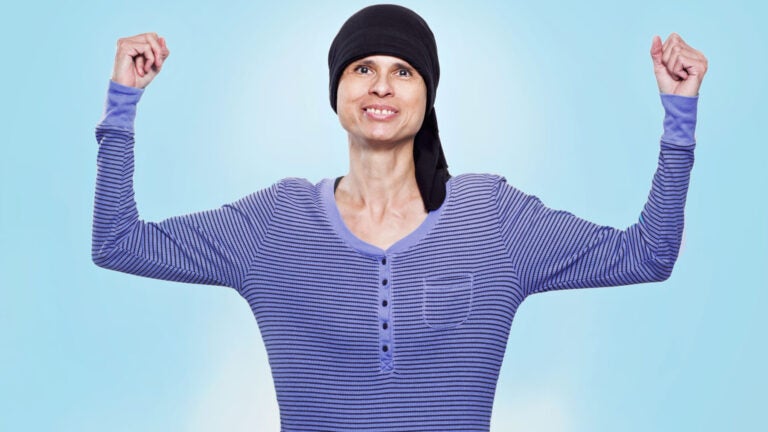
Since starting the Optimal Living program, Debulyn Salinas has made changes to improve her quality of life. (Photo/Christina Gandolfo)
Down but not out with multiple sclerosis
A mailer for USC’s Optimal Living program lands on a woman’s doorstep one day and changes her life
Debulyn Salinas was at her breaking point when she got into the USC Optimal Living with MS program in late 2015.
Her journey through the 11-week program this spring has restored her faith in people and most importantly in herself.
Salinas, now 51, was diagnosed with multiple sclerosis when she was only 24.
“There went the high heels and pencil skirts,” she quipped with a laugh, almost 30 years later.
A healthy dose of humor
Salinas hasn’t come by this sense of humor easily. Over the past five years especially, she has dealt with increasing depression and less than ideal medical treatment — factors creating a profound despair that caused her to isolate herself from friends and family.
I needed a purpose. I thought my life was over.
Debulyn Salinas
“I needed a purpose,” she explained, her voice cracking a bit. “I thought my life was over.”
As fate would have it, she received a mailer for the USC Optimal Living program in November. She mentions that she now keeps this mailer in her Bible and asserts “it’s going to stay there.”
Co-sponsored by the National Multiple Sclerosis Society, the USC Mrs. T.H. Chan Division of Occupational Science and Occupational Therapy and the USC Division of Biokinesiology and Physical Therapy, the program works with MS patients from all walks of life who are recruited by the MS Society. Salinas was selected for the spring 2016 class.
Assistant professor of clinical occupational therapy Ashley Uyeshiro Simon ’08, MA ’10, OTD ’11 explains that a main tenet of the program is Lifestyle Redesign, a treatment technique focused on helping patients improve daily habits and routines to improve their overall health outcomes.
“The most beautiful part of this model is that the participant is not just a passive recipient of therapy,” Uyeshiro Simon said. “We emphasize their role as a teacher and encourage them to teach the students what it is like to live with MS on a daily basis — the types of physical, emotional and occupational problems that they encounter.”
Conserving energy
Throughout the program, class members are paired with current USC Chan students who then work together on a variety of topics such as occupational roles and engagement, stress management and dealing with social isolation, home evaluations and safety/fall risk prevention; and self-advocacy and assertiveness.
Salinas was paired with Christina Huynh MA ’16 for a group module focused on energy conservation and fatigue management in which participants were taught how to recognize their own signs of fatigue and use different skills to conserve energy. All class modules encourage participants to analyze their own habits and routines, then implement positive changes from an arsenal of techniques at their disposal.
“This program is so amazing because it is so holistic,” Huynh said. “The participants receive OT and PT services and learn about other topics like Tai Chi, expressive journaling and nutrition.”
Hope ahead
Since participating this spring, Salinas has a newfound hope about her life.
“The therapists cared and believed in me, but they also had faith that things were going to get better,” Salinas said. “That overrode all the negativity I had been carrying around for the last five years.”
Uyeshiro Simon stresses that Salinas never hesitated to express her gratitude to the many faculty members involved. This gratitude seems to be shared by all in the program — patients, students and faculty alike.
“I taught Debulyn skills such as how to be safer in her home, to conserve energy and to manage stress, but what she taught me was bigger than that,” Huynh said. “She really showed me the importance of human connection, compassion and staying positive. And for that I am so thankful.”
Salinas will continue to project her gratitude in the future. During the photo shoot, it’s visible on her face.
“Each morning, I wake up, and even if I have nowhere to go, I still get dressed as if I’m going somewhere,” she said. “I have a large collection of pajamas; now I’m not using them as much. I want to experience life, I want to be able to say, ‘I’m in!’”
